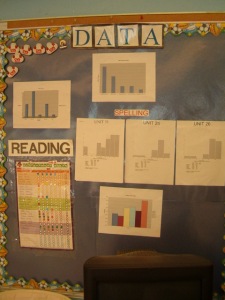
Teachers in K-12 often use student data on a regular basis. Student achievement data can be used to qualify students for reading, gifted, remedial, enrichment, acceleration, differentiation, and a variety of other services. Recently, standardized testing data has been the forefront of educational trends and in the news. Implementing a balanced approach when looking at student data can keep stakeholders (educators and administrators) grounded in an understanding that the numbers behind the tests may give light to areas of strengths/needs.
Data isn’t evil
Assessing a student’s understanding of a specific concept isn’t necessarily a bad thing. In fact, over the past few years I’ve grown to appreciate and utilize student achievement data more and more. Whether the data is from a standardized test or not, the data can be helpful if used correctly. Moving data beyond just a number can benefit teachers and students. Data can help teachers ask better questions and provide opportunities to reflect on how students learn best. Involving students in analyzing their own data can encourage student goal setting and ownership.
Having conversations with students about their data is powerful.
Have the conversation
I’m definitely not an advocate for having additional standardized tests, although some seem more useful than others. I find that assessments that give detailed feedback (e.g. areas that need strengthening, %ile compared to the norm, strength areas, next instructional steps, etc.) are more frequently used by teachers, compared to assessments the give little feedback. Obviously, there isn’t a perfect test available for school purchase. The assessments that a school uses should give detailed feedback that can be immediately used.
Do you hear a lot of negative talk in regard to standardized assessments? Having a conversation about an assessment’s effectiveness in informing instruction may be needed. Instead of trash talking the assessments in general, educators and administrators should find assessments that work for them. PLC teams should emphasize the importance of using formative assessments regularly. I’ve found that teacher created formative assessments are some of the best ways to find areas that need strengthening and to identify differentiation opportunities. The purpose of giving the assessments should be communicated to all stakeholders. When teachers understand why the tests are given, (not just for VAM reasons), they may start to value the benefits of assessing students using a variety of tools (such as Common Core performance assessments).
Balance is needed
With teaching and in life, balance is needed. Teaching is a profession that can be stressfull. It has many teachers thinking right now, how many days till Spring Break?? Balancing assessments with instruction takes skill and patience. Standardized tests are often at the forefront of school administrator’s minds. One test shouldn’t be used to determine if success, or enough growth has been made to call that school year/class/school successful. Take a breath and look at assessments from a macro lens. A combination of formative, informal, formal, review checkpoints, activators, performance (insert your assessment here), and even standardized assessments have their place in a school and can be beneficial to a certain extent. The value of the data often depends on how it’s utilized.
Picture Credit: DigitalArt
“Your assumptions are your windows on the world. Scrub them off every once in a while, or the light won’t come in.” Isaac Asimov




